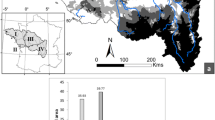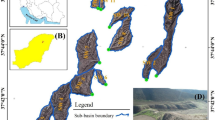Abstract
Purpose
Although contour trenching is one of the widely used nature-based solutions for soil conservation around the world, its efficiency has not been quantitatively investigated. This study aimed to scrutinize the performance of the contour trenching program, a nature-based solution and common soil erosion prevention measure in hillslopes of a data-scarce region based on the sediment connectivity approach.
Materials and methods
Six different hillslopes (A–F) were selected in the Khamsan watershed in Iran, a representative area where contour trenching has been implemented. The sediment connectivity map of each hillslope was generated using the index of connectivity (IC) based on two real scenarios: with (scenario I) and without (scenario II) contour trenching. Two different field-based validation methods were applied on the base of (i) in situ measurements of the sediment depth in contour trenches and Pearson’s correlation analysis, and (ii) field index of connectivity (FIC). The validity of the sediment connectivity results was verified using both validation approaches. The sediment connectivity in two scenarios was compared and the impact of the contour trenching was analyzed. The performance of the contour trenching program was quantitatively determined for each hillslope.
Results and discussion
The results revealed that contour trenching significantly affected sediment routing and reduced the IC values of all selected hillslopes. The differences in IC value between the two scenarios (∆IC) for hillslopes A, B, C, D, E, and F were found to be 22.6%, 11.27%, 14.69%, 5.83%, 15%, and 7.27%, respectively. Therefore, the spatial pattern of sediment connectivity also differed significantly after implementing contour trenching. Furthermore, Pearson’s correlation coefficients revealed that the sediment connectivity and the sediment depth in contours in all hillslopes had a significant negative relationship, resulting in confirming the validity of the sediment connectivity results for all six hillslopes in the current study.
Conclusion
Contour trenching significantly reduced the sediment connectivity on all six hillslopes studied. Furthermore, in situ measurements of the sediment depth in contour trenches should be conducted to verify the simulation of sediment connectivity. The proposed methodology can be applied in other data-scarce regions to evaluate the performance of the contour trenching program.







Similar content being viewed by others
Data Availability
The datasets generated during and analysed during the current study are available from the corresponding author on reasonable request.
References
Adhikary PP, Hombegowda HC, Barman D, Jakhar P, Madhu M (2017) Soil erosion control and carbon sequestration in shifting cultivated degraded highlands of eastern India: performance of two contour hedgerow systems. Agroforest Syst 91:757–771
Ali S, Sethy BK, Singh RK, Parandiyal AK, Kumar A (2017) Quantification of hydrologic response of staggered contour trenching for horti-pastoral land use system in small ravine watersheds: a paired watershed approach. Land Degrad Dev 28(4):1237–1252
Andreazzini MJ, Degiovanni SB, Benito ME, Echevarria KV (2021) Development and application of a sediment connectivity index to small fluvial catchments: a case study in Arenoso stream, Córdoba. Argentina Environ Earth Sci 80(8):1–20
Arabkhedri M, Heidary K, Parsamehr MR (2021) Relationship of sediment yield to connectivity index in small watersheds with similar erosion potentials. J Soils Sediments 21(7):2699–2708
Baartman JE, Masselink R, Keesstra SD, Temme AJ (2013) Linking landscape morphological complexity and sediment connectivity. Earth Surf Proc Land 38(12):1457–1471
Borselli L, Cassi P, Torri D (2008) Prolegomena to sediment and flow connectivity in the landscape: a GIS and field numerical assessment. CATENA 75(3):268–277
Cavalli M, Trevisani S, Comiti F, Marchi L (2013) Geomorphometric assessment of spatial sediment connectivity in small Alpine catchments. Geomorphology 188:31–41
Crema S, Cavalli M (2018) SedInConnect: a stand-alone, free and open source tool for the assessment of sediment connectivity. Comput Geosci 111:39–45
Díaz MC, Fernández-Nieto ED, Ferreiro AM (2008) Sediment transport models in shallow water equations and numerical approach by high order finite volume methods. Comput Fluids 37(3):299–316
Fryirs K (2013) (Dis) Connectivity in catchment sediment cascades: a fresh look at the sediment delivery problem. Earth Surf Proc Land 38(1):30–46
Ghosh A, Singh AK, Kumar S, Manna MC, Jha P, Bhattacharyya R, Sannagoudar MS, Singh R, Chaudhari SK, Kumar RV (2021) Do moisture conservation practices influence stability of soil organic carbon and structure?. Catena 199:105127. https://doi.org/10.1016/j.catena.2020.105127
Heckmann T, Cavalli M, Cerdan O, Foerster S, Javaux M, Lode E, Smetanová A, Vericat D, Brardinoni F (2018) Indices of sediment connectivity: opportunities, challenges and limitations. Earth-Sci Rev 187:77–108
Hooke J, Souza J (2021) Challenges of mapping, modelling and quantifying sediment connectivity. Earth-Sci Rev 223:103847. https://doi.org/10.1016/j.earscirev.2021.103847
Jiao Y, Zhao D, Xu Q, Liu Z, Ding Z, Ding Y, Liu C, Zha Z (2020) Mapping lateral and longitudinal hydrological connectivity to identify conservation priority areas in the water-holding forest in Honghe Hani Rice Terraces World Heritage Site. Landscape Ecol 35(3):709–725
Kalantari Z, Ferreira CSS, Koutsouris AJ, Ahlmer AK, Cerdà A, Destouni G (2019) Assessing flood probability for transportation infrastructure based on catchment characteristics, sediment connectivity and remotely sensed soil moisture. Sci Total Environ 661:393–406
Kumar S, Singh AK, Singh R, Ghosh A, Chaudhary M, Shukla AK, Kumar S, Singh HV, Ahmed A, Kumar RV (2019) Degraded land restoration ecological way through horti-pasture systems and soil moisture conservation to sustain productive economic viability. Land Degrad Dev 30(12):1516–1529
Kumar R, Bhardwaj AK, Rao BK, Vishwakarma AK, Bhatnagar PR, Patra S, Kumar G, Kakade V, Dinesh D, Pande VC, Singh G (2021) Development of degraded ravine lands of Western India using Sapota (Achras zapota) plantation with terracing vs. trenching-on-slope-based conservation measures. Land Degrad Dev 32(1):101–111
Li Y, Li Z, Cui S, Jagadamma S, Zhang Q (2019) Residue retention and minimum tillage improve physical environment of the soil in croplands: a global meta-analysis. Soil Till Res 194:104292. https://doi.org/10.1016/j.still.2019.06.009
Locatelli L, Mark O, Mikkelsen PS, Arnbjerg-Nielsen K, Wong T, Binning PJ (2015) Determining the extent of groundwater interference on the performance of infiltration trenches. J Hydrol 529:1360–1372
López-Vicente M, Kramer H, Keesstra S (2021) Effectiveness of soil erosion barriers to reduce sediment connectivity at small basin scale in a fire-affected forest. J Environ Manage 278:111510. https://doi.org/10.1016/j.jenvman.2020.111510
Mahajan GR, Das B, Manivannan S, Manjunath BL, Verma RR, Desai S, Kulkarni RM, Latare AM, Sale R, Murgaonkar D, Patel KP (2021) Soil and water conservation measures improve soil carbon sequestration and soil quality under cashews. Int J Sediment Res 36(2):190–206
Mekonnen M, Keesstra SD, Baartman JE, Stroosnijder L, Maroulis J (2017) Reducing sediment connectivity through man-made and natural sediment sinks in the Minizr catchment. Northwest Ethiopia Land Degrad Dev 28(2):708–717
Mombini A, Amanian N, Talebi A, Kiani-Harchegani M, Rodrigo-Comino J (2021) Surface roughness effects on soil loss rate in complex hillslopes under laboratory conditions. Catena 206:105503. https://doi.org/10.1016/j.catena.2021.105503
Najafi S, Dragovich D, Heckmann T, Sadeghi SH (2021) Sediment connectivity concepts and approaches. Catena 196:104880. https://doi.org/10.1016/j.catena.2020.104880
Panigrahi P, Srivastava AK, Pradhan S (2021) Runoff and soil conservation effects in Nagpur mandarin orchard under a sub-humid tropical climate of central India. Agr Water Manage 258:107185. https://doi.org/10.1016/j.agwat.2021.107185
Persichillo MG, Bordoni M, Cavalli M, Crema S, Meisina C (2018) The role of human activities on sediment connectivity of shallow landslides. CATENA 160:261–274
Poeppl RE, Fryirs KA, Tunnicliffe J, Brierley GJ (2020) Managing sediment (dis) connectivity in fluvial systems. Sci Total Environ 736:139627. https://doi.org/10.1016/j.scitotenv.2020.139627.
Singh G, Mishra D, Singh K, Parmar R (2013) Effects of rainwater harvesting on plant growth, soil water dynamics and herbaceous biomass during rehabilitation of degraded hills in Rajasthan, India. Forest Ecol Manag 310:612–622
Tarolli P, Cavalli M, Masin R (2019) High-resolution morphologic characterization of conservation agriculture. CATENA 172:846–856
Tian X, Wang K, Liu Y, Fan H, Wang J, An M (2020) Effects of polymer materials on soil physicochemical properties and bacterial community structure under drip irrigation. Appl Soil Ecol 150:103456. https://doi.org/10.1016/j.apsoil.2019.103456
Varade AM, Khare YD, Mondal NC, Muley S, Wankawar P, Raut P (2013) Identification of water conservation sites in a watershed (WRJ-2) of Nagpur District, Maharashtra using geographical information system (GIS) technique. J Indian Soc Remot 41:619–630
Wang B, Steiner J, Zheng F, Gowda P (2017) Impact of rainfall pattern on interrill erosion process. Earth Surf Proc Land 42(12):1833–1846
Wolka K, Biazin B, Martinsen V, Mulder J (2021) Soil and water conservation management on hill slopes in southwest Ethiopia. II. Modeling effects of soil bunds on surface runoff and maize yield using AquaCrop. J Environ Manage 296:113187. https://doi.org/10.1016/j.jenvman.2021.113187
Yeshaneh E, Eder A, Blöschl G (2014) Temporal variation of suspended sediment transport in the Koga catchment, North Western Ethiopia and environmental implications. Hydrol Process 28(24):5972–5984
Zanandrea F, Michel GP, Kobiyama M (2020) Impedance influence on the index of sediment connectivity in a forested mountainous catchment. Geomorphology 351:106962. https://doi.org/10.1016/j.geomorph.2019.106962
Zanandrea F, Michel GP, Kobiyama M, Censi G, Abatti BH (2021) Spatial-temporal assessment of water and sediment connectivity through a modified connectivity index in a subtropical mountainous catchment. Catena 204:105380. https://doi.org/10.1016/j.catena.2021.105380
Acknowledgements
This manuscript was prepared based on a part of scientific outputs from the project “24-53-29-051-000936” in 2021. We greatly thank Mr. Ramyar Aliramaee for supporting the fieldwork in the Khamsan region. The authors are grateful to the assistance of the Editor-in-Chief, Prof. Philip N. Owens, Submissions Editor, Dr. Simon Pulley, and anonymous reviewers for their constructive suggestions/comments that enhanced the quality and scientific value of the manuscript.
Funding
The research was funded by the Natural Resources and Watershed Management Department of Kurdistan Province, and scientifically confirmed by the Agricultural Research, Education and Extension Organization (AREEO) and Soil Conservation and Watershed Management Research Institute (SCWMRI).
Author information
Authors and Affiliations
Corresponding author
Ethics declarations
Competing interests
The authors declare no competing interests.
Additional information
Responsible editor: Simon Pulley
Publisher's Note
Springer Nature remains neutral with regard to jurisdictional claims in published maps and institutional affiliations.
Rights and permissions
Springer Nature or its licensor (e.g. a society or other partner) holds exclusive rights to this article under a publishing agreement with the author(s) or other rightsholder(s); author self-archiving of the accepted manuscript version of this article is solely governed by the terms of such publishing agreement and applicable law.
About this article
Cite this article
Rahmati, O., Soleimanpour, S.M., Arabkhedri, M. et al. Towards quantification of soil conservation performance using sediment connectivity concept at hillslope scale: proposing a new framework for data-scarce regions. J Soils Sediments 23, 2298–2309 (2023). https://doi.org/10.1007/s11368-023-03491-1
Received:
Accepted:
Published:
Issue Date:
DOI: https://doi.org/10.1007/s11368-023-03491-1




